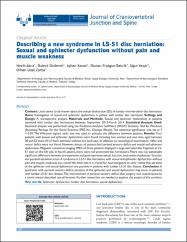Describing a new syndrome in L5-S1 disc herniation: Sexual and sphincter dysfunction without pain and muscle weakness
Künye
Akca, N., Ozdemir, B., Kanat, A., Batcik, O.E., Yazar, U., Zorba, O.U, (2014).Describing a new syndrome in L5-S1 disc herniation: Sexual and sphincter dysfunction without pain and muscle weakness.Journal of Craniovertebral Junction and Spine, 5(4), 146-150. https://doi.org/10.4103/0974-8237.147076Özet
Context: Little seems to be known about the sexual dysfunction (SD) in lumbar intervertebral disc herniation. Aims: Investigation of sexual and sphincter dysfunction in patient with lumbar disc hernitions. Settings and Design: A retrospective analysis. Materials and Methods: Sexual and sphincter dysfunction in patients admitted with lumbar disc herniations between September 2012-March 2014. Statistical Analysis Used: Statistical analysis was performed using the Predictive Analytics SoftWare (PASW) Statistics 18.0 for Windows (Statistical Package for the Social Sciences, SPSS Inc., Chicago, Illinois). The statistical significance was set at P < 0.05. The Wilcoxon signed ranks test was used to evaluate the difference between patients. Results: Four patients with sexual and sphincter dysfunction were found, including two women and two men, aged between 20 and 52 years. All of them admitted without low back pain. In addition, on neurological examination, reflex and motor deficit were not found. However, almost all patients had perianal sensory deficit and sexual and sphincter dysfunction. Magnetic resonance imaging (MRI) of three patients displayed a large extruded disc fragment at L5-S1 level on the left side. In fourth patient, there were not prominent disc herniations. There was not statistically significant difference between pre-operative and post-operative sexual function, anal-urethral sphincter function, and perianal sensation score. A syndrome in L5-S1 disc herniation with sexual and sphincter dysfunction without pain and muscle weakness was noted. We think that it is crucial for neurosurgeons to early realise that paralysis of the sphincter and sexual dysfunction are possible in patients with lumbar L5-S1 disc disease. Conclusion: A syndrome with perianal sensory deficit, paralysis of the sphincter, and sexual dysfunction may occur in patients with lumbar L5-S1 disc disease. The improvement of perianal sensory deficit after surgery was counteracted by a trend toward disturbed sexual function. Further researches are needed to explore the extent of this problem.


















